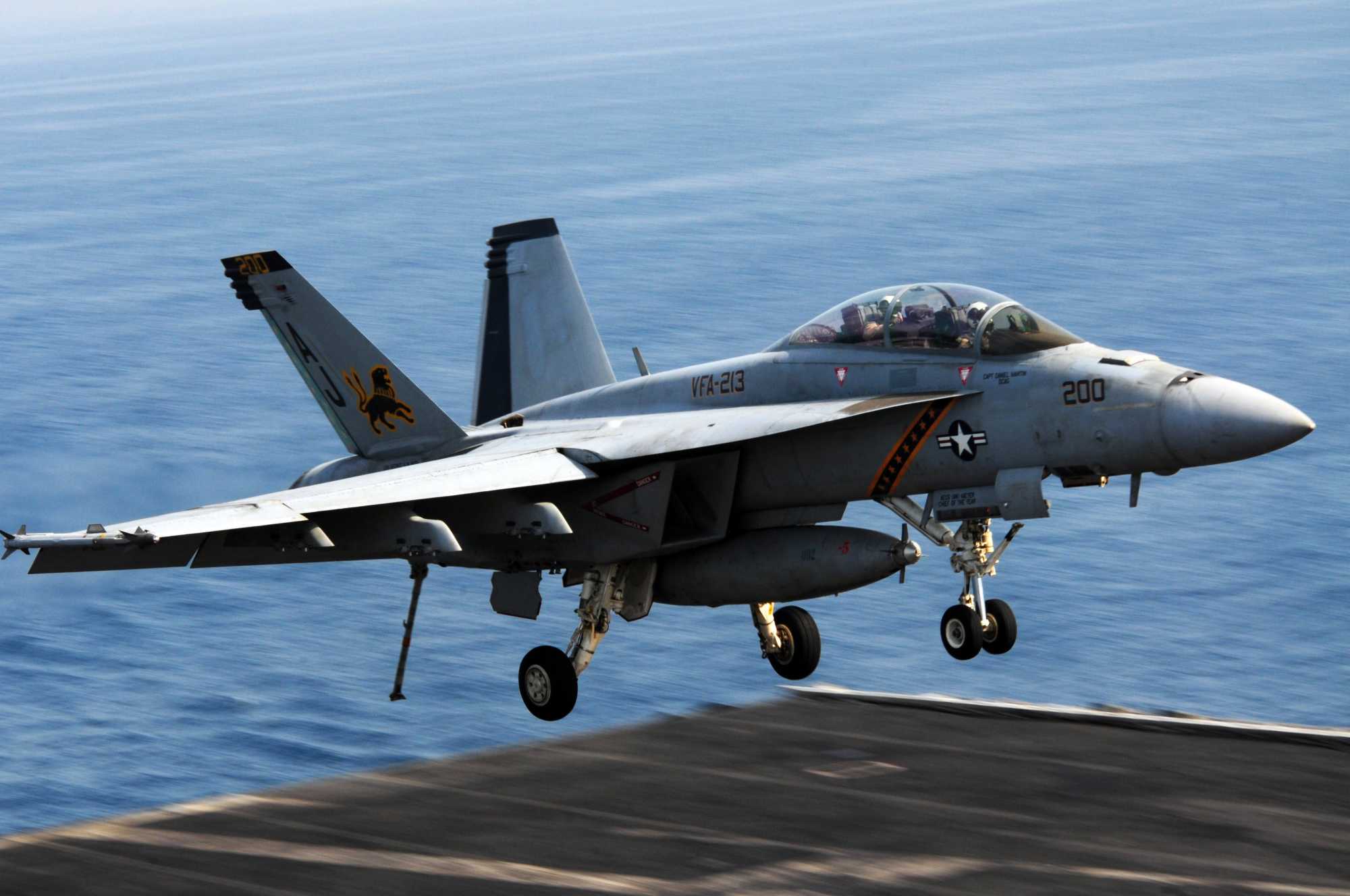The United States has launched a massive military mobilisation in the Middle East amid escalating Israel-Iran conflict. This includes the redeployment of the US Navy’s USS Nimitz aircraft carrier armed with cutting-edge and ever-reliable F/A-18 Super Hornets.
The USS Nimitz, which is due to arrive in the theatre some time this week, will join the USS Carl Vinson, which has been sailing in the region for some time. Notably, Nimitz will be the fifth carrier to be deployed to the tumultuous Middle East by the Pentagon since late 2023.
The air wing of the carrier USS Nimitz (CVN 68) consists of nine squadrons flying F/A-18C/E/F Super Hornets, EA-18G Growlers, E-2D Hawkeyes, C-2A Greyhounds, and MH-60R/S Sea Hawks.
Meanwhile, the air wing of USS Carl Vinson (CVN 70) consists of nine squadrons flying F-35C Lightning II, F/A-18E/F Super Hornets, EA-18G Growlers, E-2D Advanced Hawkeyes, CMV-22 Ospreys, and MH-60R/S Sea Hawks.
This means that a formidable force of carrier-capable fighter jets will be positioned in the region, waiting for orders to launch strikes in case the United States formally joins the war against Iran.
In an alternative scenario, they will be used to shooting down hostile missiles and drones headed towards Israel. These aircraft will likely be joined by F-35 and F-22, which have been dispatched to the Middle East.
Since the Hamas October 7 attack on Israel, the US has moved several state-of-the-art military assets to the region to defend its closest ally against hostile missile and drone attacks from Iran’s proxies.
The F-35C Lightning II stealth aircraft is relatively new to this game and made its combat debut in targeted strikes against Yemen-based Houthi militia in November 2024. However, the F/A-18 Super Hornet, the Top Gun aircraft, has been the workhorse of the US Navy in the region for several years.
While the service lost three Super Hornets in less than six months while fighting the Iran-backed Houthi militia, the aircraft has historically proved instrumental in neutralising threats, particularly in the Middle East.
The aircraft secured its first and most stunning kills eight years ago when it shot down a Soviet-origin Su-22 in Syria.
The Infamous Super Hornet Shootdown of Su-22
The United States formed a coalition of allies and went to war against the Islamic State in September 2014 under ‘Operation Inherent Resolve.’
The objective of this operation was to neutralize the terrorist organisation’s territorial caliphate, disrupt its command structure, and permanently destroy its ability to make a resurgence.
The operation began with air strikes in September 2014.
The US Navy F/A-18 Super Hornets, operating from carriers, conducted thousands of airstrikes between 2014 and 2017.
The aircraft delivered precision munitions, including the JDAMs, laser-guided bombs, AGM-154 JSOWs, against ISIS targets, including command centers, weapons caches, and vehicle convoys. The AN/ASQ-228 ATFLIR pod mounted on the Super Hornets enabled precise targeting in urban areas, minimizing civilian casualties.
The Super Hornets were deployed to provide close air support (CAS) to Syrian Democratic Forces (SDF), a Kurdish-Arab coalition that was the primary US partner in Syria, in addition to conducting air strikes.
However, it was not an easy task to fly sorties over Syria because with American, Russian, Syrian, and Iranian forces all operating in close vicinity, the airspace was congested.

Tensions were high due to divergent goals, but the US maintained a deconfliction line with Russia to prevent direct contact and potential incidents.
Iran and Russia supported the former Syrian leader Bashar al-Assad’s regime, whereas the US maintained that it operated in the country only to dismantle the ISIS threat. That version was rejected by Bashar al-Assad’s government and its sympathisers who suspected that Washington had ulterior motives.
Things escalated between the two camps when, in April 2017, the US-led coalition launched attacks against pro-Syrian government forces at the Shayrat Airbase using Tomahawk cruise missiles in response to an alleged chemical attack conducted by the Syrian forces in the town of Khan Shaykhun in Idlib using fighter jets.
While the Syrian government denied its involvement in the attack, saying that it was a “fabrication,” the Russian government said that the incident was staged.
However, the US intelligence, along with the United Kingdom, Turkey, Saudi Arabia, France, and Israel, as well as Human Rights Watch, had all attributed the attack to Syrian forces and justified the US bombing of a Syrian airbase, complicating the security situation in the strife-hit country.
The US-led coalition alleged that Assad’s forces were often found attacking the SDF, which was a rival of the regime during the Syrian Civil War. The complex and evolving situation in Syria at the time meant that the rules of engagement between all the active forces in the country were regularly changing.
It was in this unique battlefield that, on June 18, 2017, the Super Hornet jets found themselves in the middle of an air-to-air engagement that they did not ask for.
Super Hornet’s First Kill
Syrian Government forces attacked SDF positions in Ja’Din on June 18 and wounded multiple fighters, before coalition planes responded with a “show of force” to halt the offensive.
Two F/A-18E pilots, Lieutenant Commander Michael “Mob” Tremel (call sign Freedom 33) and wingman Jeff Krueger (call sign Freedom 34), were dispatched from the carrier into Syria following their pre-mission briefing. Two F/A-18Cs, designated Freedom 43 and 44, flown by Stephen Gasecki and William Vuillet, accompanied them.
They entered Syria via the northern route, which probably passed over Turkey and past Russian air defenses positioned along the country’s coast. Upon arrival, the aircraft made contact with the Joint Terminal Air Controller (JTAC) on the ground south of Al Tabqa in Syria, where Syrian forces were rapidly approaching friendly forces.
The mission, as per the US version, started as just another close air support sortie over Syria. So, all four strike jets moved into the close air support stack (CAS stack) over the JTAC and awaited strike requests.
However, before a strike request could be made, a Russian Su-27 started to hover high overhead the Super Hornets. Other reports suggested it was a Su-35 and not a Su-27.
While the other pilots resumed their CAS mission, Mob, who was experiencing problems with his targeting pod, was tasked with monitoring the circling Russian jet. Switching the Super Hornet’s master mode to air-to-air, he started monitoring the Su-27/Su-35 and looking for additional planes that may be in the vicinity.
He then saw another radar track—a swiftly approaching aircraft from the south. Mob proceeded to intercept the target and finally identified it visually as a Su-22 ‘Fitter’ swing-wing attack jet from the Syrian Air Force. It was the same aircraft that had allegedly conducted the chemical attack in March.
After spotting the Su-22, Mob connected to an E-3 Sentry, an airborne command and control station, and instructed it to broadcast warnings to the Syrian jet over guard frequency constantly. However, stubborn as he was, the Syrian pilot did not alter course in response to the radio communications.
Mob’s Super Hornet performed a “head-butt” maneuver, flying close to the Su-22 and firing warning flares to deter it. Then, to scare him away, Mob even “thumped” the Su-22 three times while flying close over the jet’s canopy. That also did not deter the Syrian pilot from turning away, according to the pilot’s version of events.
Instead of backing off, the Syrian aircraft started to dive and release weapons, before making a climb.
By this time, Mob received authorization to engage under self-defense protocols. He used an AIM-9X Sidewinder to lock the Su-22 up from behind. While the missile sped off the aircraft’s wing rail with a trail of smoke, it somehow vanished in an instant. The Su-22’s Soviet-era flare system proved effective against the modern missile.
The pilot did not quite understand why the missile was unable to track the Su-22. So, he picked up an AIM-120 AMRAAM in a flash and shot again.
This time, he recorded the time it took for the missile to launch from the “cheek” station of the Super Hornet. The missile tracked the Fitter flying a few feet away and detonated on its rear, forcefully throwing it to the right and then downward. Mob saw the pilot of the doomed aircraft eject.

It was the first time a US warplane shot down a manned aircraft since a USAF F-16 downed a Yugoslav Air Force MiG-29 in 1999.
The engagement lasted approximately eight minutes, occurring at a low altitude of around 10,000–15,000 feet and within visual range, despite the AMRAAM’s long-range capability. Tremel and his wingman safely returned to USS George H.W. Bush.
The Pentagon described the shootdown as a defensive action to protect SDF forces, emphasizing adherence to rules of engagement. The US reiterated that its focus was solely on ISIS, not the Syrian regime. However, Syria condemned the shootdown as “aggression,” claiming the Su-22 was attacking ISIS, not SDF.
Damascus reported the pilot missing. Later, Captain Ali Fahd was found alive by Syrian troops one day later in the village of Shuwaihat.
Russia, on the other hand, criticized the US and temporarily suspended deconfliction coordination while threatening to track coalition aircraft as targets west of the Euphrates. However, it did not launch an armed retaliation.
The F/A-18E involved in the shoot down received a kill marking—a Syrian flag with a Su-22 silhouette—painted below the canopy, and the aviator, Lt. Cmdr. Tremel, was awarded the Distinguished Flying Cross for his actions.
The event validated the F/A-18E’s air-to-air capabilities, previously untested in combat. It highlighted the platform’s versatility, as Tremel’s jet was configured for a multirole mission, not dedicated air superiority.



